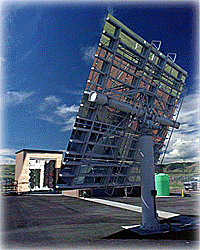High-Flux Solar Furnace

The photo above shows the High-Flux Solar Furnace's primary components.
The large flat mirror in the foreground, called a
heliostat, tracks the sun and reflects solar
energy onto the 25 individual curved
mirrors that are collectively referred to as the primary concentrator. These
curved mirrors focus the solar
flux at a target area in the test building. The long focal length
of the primary concentrator in the background of the picture
produces a concentrated beam (diameter: 10 cm) with the energy of approximately
2500 suns at the focal point, which is not visible here. When a reflective
secondary concentrator is placed at the focus, a flux of more than 20,000 suns
can be achieved.
Researchers create highly concentrated solar energy, called solar flux, by
reflecting sunlight from precisely
curved mirrors, similar to the way a satellite dish reflects radio waves to
a point. Solar energy can be
concentrated from a few hundred to tens-of-thousands times of the normal
intensity of the sun at the
Earth's surface. This intense energy creates and sustains extremely high
but very localized temperatures,
modest concentrations of 2500 suns can easily burn through 1/4-inch (approx.
6 mm) steel.
The surface of a material exposed to high solar flux also heats rapidly while
the base or substrate remains relatively unaffected. Such rapid
surface heating allows advanced surface processes such as ceramic
metallization and chemical vapor deposition to be performed.


Questions, comments, t-shirts, cookies, pizza, milk and honey to:
Mustafa Mesanovic <mm@rhlx01.rz.fht-esslingen.de>
Nils Philippsen <nils@rhlx01.rz.fht-esslingen.de>
1996-11-29



